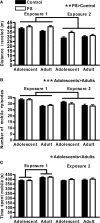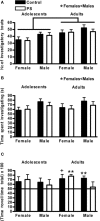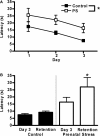Characterization of the cognitive impairments induced by prenatal exposure to stress in the rat
- PMID: 21151368
- PMCID: PMC2996142
- DOI: 10.3389/fnbeh.2010.00173
Characterization of the cognitive impairments induced by prenatal exposure to stress in the rat
Abstract
We have previously shown that male rats exposed to gestational stress exhibit phenotypes resembling what is observed in schizophrenia, including hypersensitivity to amphetamine, blunted sensory gating, disrupted social behavior, impaired stress axis regulation, and aberrant prefrontal expression of genes involved in synaptic plasticity. Maternal psychological stress during pregnancy has been associated with adverse cognitive outcomes among children, as well as an increased risk for developing schizophrenia, which is characterized by significant cognitive deficits. We sought to characterize the long-term cognitive outcome of prenatal stress using a preclinical paradigm, which is readily amenable to the development of novel therapeutic strategies. Rats exposed to repeated variable prenatal stress during the third week of gestation were evaluated using a battery of cognitive tests, including the novel object recognition task, cued and contextual fear conditioning, the Morris water maze, and iterative versions of a paradigm in which working and reference memory for both objects and spatial locations can be assessed (the "Can Test"). Prenatally stressed males were impaired relative to controls on each of these tasks, confirming the face validity of this preclinical paradigm and extending the cognitive implications of prenatal stress exposure beyond the hippocampus. Interestingly, in experiments where both sexes were included, the performance of females was found to be less affected by prenatal stress compared to that of males. This could be related to the finding that women are less vulnerable than men to schizophrenia, and merits further investigation.
Keywords: adolescence; animal models; cognition; gestational stress; schizophrenia; sex differences.
Figures







References
-
- Adler L. E., Olincy A., Waldo M., Harris J. G., Griffith J., Stevens K., Flach K., Nagamoto H., Bickford P., Leonard S., Freedman R. (1998). Schizophrenia, sensory gating, and nicotinic receptors. Schizophr. Bull. 24, 189–202 - PubMed
Grants and funding
LinkOut - more resources
Full Text Sources

